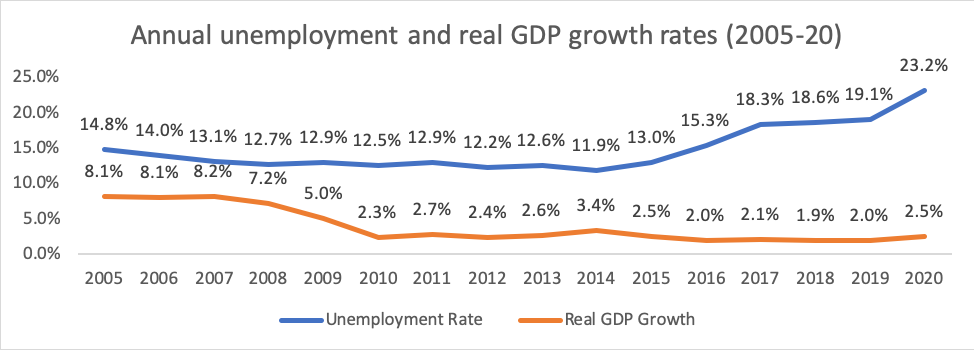In the last few years, it has become conventional wisdom that unemployment is Jordan’s most pressing challenge. While King Abdullah himself has stressed on many occasions that reducing unemployment is a top priority, the number of unemployed is still on the rise.
Currently, the overall unemployment rate among Jordanians is 25%. Unemployment among those aged 20-24 and 25-29 is even higher, reaching 61.5% and 36.5% respectively. Jordanian officials usually justify this situation by pointing to COVID-19 and the sluggish economic growth. However, unemployment in the kingdom is more of a long-term structural issue rather than the result of exogenous shocks. Even though regional turmoil and the pandemic had a formidable negative impact, Jordan’s labor market problems cannot be considered recent. Structural distortions in its labor market long predate the pandemic and even the Arab Spring. This problem can be overcome with evidence-based active labor market policies (ALMPs), which are lacking in Jordan. Such policies have helped countries like Saudi Arabia and Egypt to mitigate chronic labor market issues. In 2015, Saudi Arabia cooperated with Harvard’s Evidence for Policy Design center to successfully design and implement its ALMPs. This program helped Saudi Arabia to improve the employability of female workers and youth and address supply-demand mismatches. Unlike Saudi Arabia’s recent effort, however, the Jordanian government’s approach toward labor market policies is based on perceptions rather than evidence.
Why economic growth is not a sufficient remedy
Historical data indicates that Jordan’s unemployment problem is a long-standing structural issue. For instance, although economic growth exceeded 5% during the period 2005-09, unemployment rates remained high for the same period (13.5% on average), as shown in the graph below. This indicates a high level of structural unemployment. Moreover, despite the fact that 62% of Jordan’s population is between 15 and 65 years old (working age), the country has an extremely low economic participation rate (34% in 2020). International Labor Organization (ILO) data shows that Jordan had the lowest male labor force participation rate in the MENA region in 2019 (61.2%), as well as the third-lowest female rate (13.4%) worldwide.

According to the World Bank’s “Job Diagnostic” report on Jordan published in 2019, the Jordanian economy needs to grow by “at least six percent” annually to create sufficient jobs. These rates are hard to achieve given the current circumstances. Moreover, the sectors contributing high economic growth are ones that mainly create jobs for low-skilled laborers (real estate, manufacturing), or sectors that cannot absorb more employment (producers of government services).
More importantly, Jordanians face significant barriers that prevent them from joining or staying in the labor market. To address these issues, structural reforms in the education system, labor market, and the overall business environment are necessary to tackle unemployment in Jordan.
Haphazard labor market policies
Despite having low employment rates, many argue that Jordan has a highly educated population; however, when it comes to the Jordanian labor skillset, paradoxes exist. In terms of formal education, the population is highly educated: 98.8% of the population attended secondary school, and 39.4% graduated from first degree programs in tertiary education. However, these numbers only reflect the level of schooling completed as opposed to the quality of education. In the context of education, pairing educational attainment with labor market skills is misleading.
Different international indicators make clear that the quality of education in the country does not meet the standards needed to improve Jordanians’ employability. The World Bank’s Human Capital Index shows that 52% of Jordanian kids suffer from learning poverty — the inability to read and comprehend by the age of 10 — which is higher than “both the average for its region (48%) and the average for its income group (38%).” Moreover, according to the World Economic Forum Global Competitiveness Index 2019, Jordan ranks 58th globally in terms of labor skills, behind regional competitors like Israel, Saudi Arabia, the UAE, Qatar, and Bahrain. This performance makes it less likely that the international private sector will invest in Jordan due to the lack of competitive labor skills. In fact, a recent USAID survey showed that 35% of the business sector in Jordan said that “companies can’t find people with the skills required to fill their vacancies.”
Notwithstanding the obvious need for professional upskilling programs, survey data shows that businesses in Jordan believe that “high-quality professional training services” are lacking. In fact, more than 65% of businesses reported that such professional upskilling programs are not available in the country.
The available data on ALMPs implemented in Jordan indicates that governmental investments in these programs are minimal. In 2021, the Jordanian government allocated $2.63 million through the Ministry of Labor for these programs, which constitutes less than 0.1% of total government spending. In addition to the weak public investment in labor force development, these programs also suffer from other major distortions. For starters, they are limited to vocational training instead of professional upskilling for educated people. This also applies to programs financed and implemented by international donors and development organizations. The majority of these programs are based either on the donors or local officials’ perceptions instead of evidence. One of these externally funded programs focused on training women on plumbing skills, a sector that is extremely hard for women in Jordan to penetrate due to its domination by men and prevailing social norms. If these funds and efforts were better guided by data, this would help in mitigating the structural barriers to women’s economic participation instead of allocating funds toward unrealistic solutions. For instance, a recent World Bank report shows that better-educated workers — especially women — face the biggest challenges when seeking jobs in Jordan. These difficulties are explained by the lack of soft skills (including skills like CV writing, communication, language, professional writing, and others) and the inadequacy of demand-driven upskilling programs.
Instead of waiting for economic growth, the Jordanian government and international donors need to cooperate with the private sector to design evidence-based and demand-driven ALMPs. Without evidence-based programs and continuous quantitative evaluation, Jordan will not be able to effectively solve its structural labor market distortions.
Laith Alajlouni is a Jordanian political economist and social policy researcher specializing in the political economy of development in the Middle East region. The views expressed in this piece are his own.
Photo by KHALIL MAZRAAWI/AFP via Getty Images
The Middle East Institute (MEI) is an independent, non-partisan, non-for-profit, educational organization. It does not engage in advocacy and its scholars’ opinions are their own. MEI welcomes financial donations, but retains sole editorial control over its work and its publications reflect only the authors’ views. For a listing of MEI donors, please click here.













